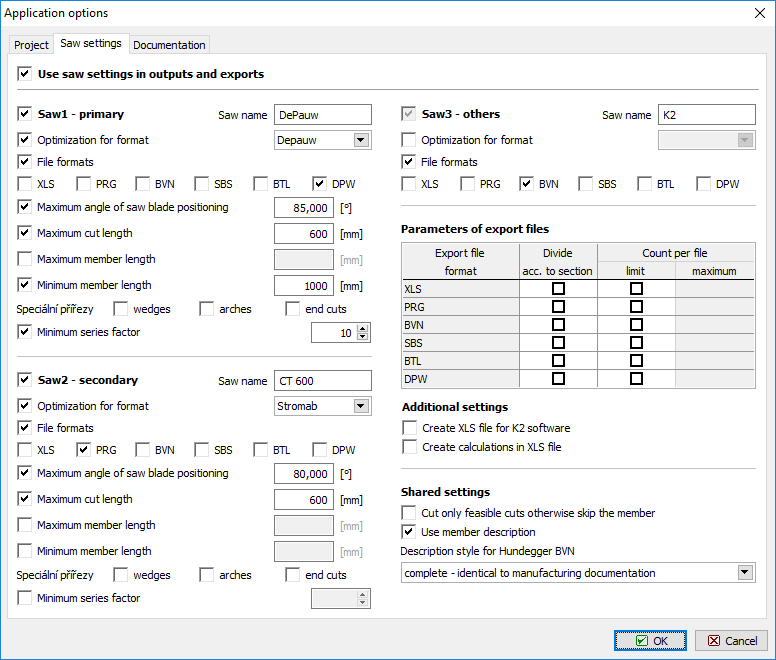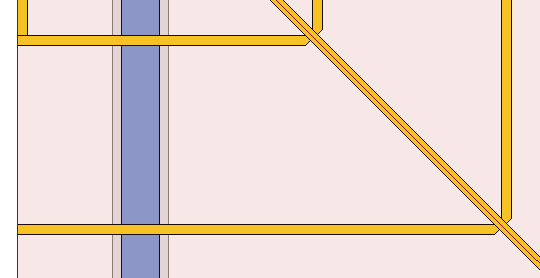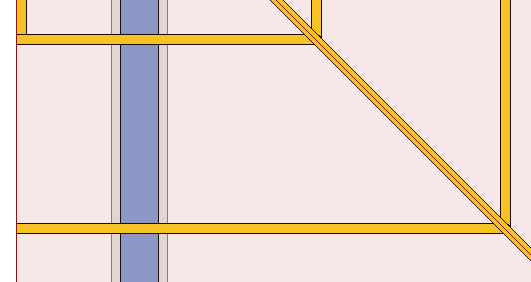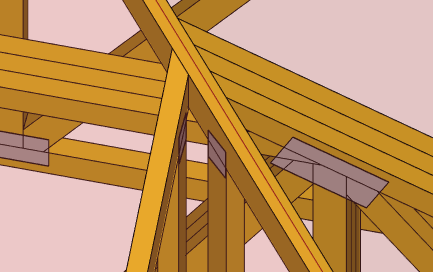Version 10
New features in the version 10:
National annex for Austria
The support of Austrian standards ÖNORM B EN 1990-1, ÖNORM B EN 1991-1-1, ÖNORM B EN 1991-1-3, ÖNORM B EN 1991-1-4 and ÖNORM B EN 1995-1-1 was added into programs. These standards correspond to the national annexes to Eurocodes. The eccentricities of anchorage areas (chapter 8.8 in ÖNORM B EN 1995-1-1) are considered as additional bending moments during nail plate design.
Beveled cuts
Beveled cuts can be created in the software "Truss 3D". These cuts appear at the ends of extended rafters and bottom chords and the angle corresponds to the angle between connected trusses. These cuts can be processed by some saw machines (e.g. Hundegger, Weinmann) during truss manufacturing. Such production reduces assembly time on site.
End cuts can be switched on in the window "Common settings" in the tab "Mounting". The end cuts contain following settings: The setting "Symmetrical detail for single cut" creates symmetrical double cut instead of single cut. These trusses can be used bot on the left and right sides of the structure. Otherwise, left and right trusses have to be manufactured.
|
|
Symmetrical double cut | Different single cuts on the left and right sides |
The geometry of particular plies in multi-ply girders can be affected by the setting "All plies identical in multi-ply girders". If the setting is switched on, all plies are identical. Otherwise, every ply has different length. This setting affects only girders with single cuts.
|
|
Identical plies in multi-ply girder | Different plies in multi-ply girder |
Extended options fir manufacturing documentation and saw exports
Significant changes were made in production documentation and saw processing. The cutting bill can be divided up to three different parts, every part can be processed using different type of saw machine. The parameters which affect this behaviour are placed in the window "Application options", tabs "Saw settings" and "Documentation". The tab "Saw settings" contains an option to divide cutting bill according to characteristics of saw machines (blade diameter etc.) or user-defined preferences (series factor). Three saw machines can be used for timber processing:
- Primary – The most preferred saw machine. If used, the software tries to assign maximum of timber members to this saw. Only members which don’t suit given conditions (series factors, saw characteristics) are assigned to secondary saw or to saw for remaining members.
- Secondary – If used, the software tries to assign maximum of timber members, which didn’t suit conditions for primary saw. The remaining members are automatically assigned to saw machine for other members.
- Others – All members which didn’t fulfill conditions given for primary or secondary saw machine are assigned to this saw machine. It is used for all members if primary and secondary saws are not used.
The setting "Optimization for format" rotates or mirrors member geometry according to preferences of selected saw machine. The table "Parameters of saw exports" can be used for division of export files according to cross-section dimensions or maximum count of members. The export files are created according to these setting, if the link "File" - "Export" - "Saw export" - "Advanced saw export" in the main menu is used. Other options in the part "Saw export" produce files with complete list of members. The tab "Documentation" allows user to divide documentation in the same way as saw exports. The member description can be modified according to dimensioning style of corresponding saw machine. As the range of these new settings is wide, we recommend to contact software support for finding correct settings for production.
 Primary saw is DePauw. Members, which does not suit conditions of primary saw (series factor, minimum length, blade angle and diameter) should be assigned to secondary saw (CT 600). The members which does not suit conditions for CT 600 (angle, cut length) are processed using K2 saw machine
Primary saw is DePauw. Members, which does not suit conditions of primary saw (series factor, minimum length, blade angle and diameter) should be assigned to secondary saw (CT 600). The members which does not suit conditions for CT 600 (angle, cut length) are processed using K2 saw machine
Extended table in "Truss check"
The table of trusses in the part "Truss check" of "Truss 3D" contains new columns (truss thickness, ply, factor ksys).
Choice of detail in step down hip
Step down hip contains an option to define cut style in upper details of hip trusses. Following options can be selected:
Automatically |
|
Top chord parallelly |
|
Intersection |
|
Rafter vertically |
|
 Choice of upper detail in step down hip
Choice of upper detail in step down hip
New printing window
The printing window was redesigned. New window supports display of more pages on the screen or continuous text selection.



